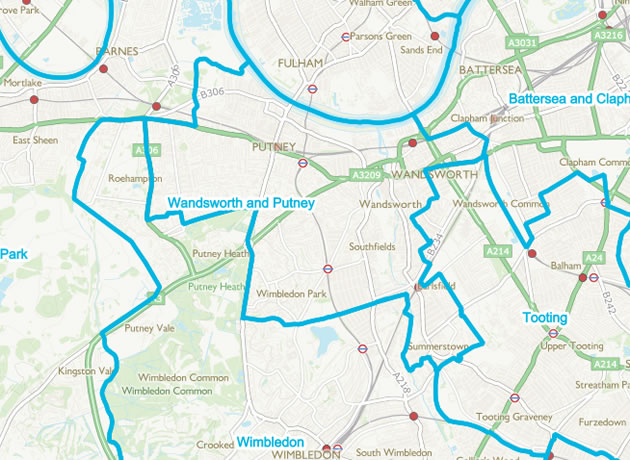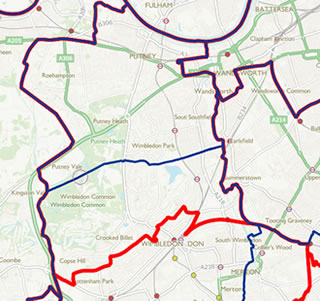Western part of Justine Greening's seat would become part of Wimbledon

The proposed Wandsworth and Putney constituency
|
A new eight week consultation period has started for residents to comment on the revised proposals to change parliamentary boundaries.
The radical changes include splitting up the current Putney constituency with the Roehampton and Putney Heath ward being moved into a Wimbledon constituency. The remainder of the seat, which is currently represented by Justine Greening, would incorporate wards around the centre of Wandsworth and be called Wandsworth and Putney.
The decision to put Roehampton & Putney Heath into the Wimbledon was proposed by the Liberal
Democrat Party.
The assistant commissioners visited the area and reported that they, 'visited
the Roehampton and Putney Heath,
and Village wards and travelled into
the centre of Wimbledon. In their view,
they considered that both Village and
Wimbledon Park wards were an integral
part of the Wimbledon constituency.
They also noted that the open space
of Wimbledon Common was used by
residents in the boroughs of Merton
and Wandsworth, on both sides of the
common, and that the Roehampton and
Putney Heath ward in particular had links
to the common and the Village ward and that it would be desirable to also include
the Roehampton and Putney Heath
ward in a Wimbledon constituency'.
The removal of the Roehampton
and Putney Heath, Village, and Wimbledon
Park wards from the initial proposals
for a Wimbledon Common and Putney
constituency meant that that constituency
electorate would be more than 5% below
the permitted electorate range and
other wards would have to be included
to compensate.

Original proposal to absorb part of Wimbledon
The assistant commissioners observed that
there were links between the Earlsfield
ward and Putney and, in particular, the
Southfields ward, and that the inclusion
of this ward, as well as the Fairfield ward,
would provide a better fit of wards than
the inclusion of the Wandsworth Common
ward and that it resulted in a more
cohesive shape to the constituency. They
therefore recommended this configuration
for the constituency and, to reflect the
changes that they had made, suggested
that the constituency should be called
Wandsworth and Putney.
The earlier proposal to absorb part of the Wimbledon Parliamentary constituency has been dropped following considerable objections generally from Wimbledon residents. An example being Jacqueline Wood (BCE-27348), ‘it seems totally crazy and bizarre to split Wimbledon in this way. I have lived in Wimbledon village all my adult life, but I walk daily to the station, shop in the Centre and the supermarkets down the hill. It’s ALL Wimbledon. I would hate the village to be separated from the life down the hill. I have very little knowledge of Putney. The Common and the A3 make a strong barrier between the two areas.’
The revised proposal for the Wandsworth and Putney would have a total of 72,359 voters:
Earlsfield - 10,820
East Putney - 10,060
Fairfield - 9,986
Southfields - 11,168
Thamesfield - 10,761
West Hill - 9,704
West Putney - 9,860
To find out more about the revised proposals and to submit comments visit www.bce2018.org.uk.
Sam Hartley, Secretary to the Boundary Commission for England, said: "We're delighted with the huge number of comments on our initial proposals that we've received from members of the public, many of which contain valuable evidence about people's local communities. Based on what people have said to us, we have revised more than half of our initial proposals.
"The new map of the country we publish today is, we think, close to the best set of Parliamentary constituencies we can achieve, based on the rules to which we work and the evidence given to us by local citizens. But we still want people to tell us what they think of this latest map before we make our final recommendations to Parliament next year. It's so important to have your say in this fundamental democratic exercise."
The rules set out in the legislation on boundary changes state that there will be 600 Parliamentary constituencies covering the UK – a reduction of 50 from the current number. This means that the number of constituencies in England must be reduced from 533 to 501. The reduction was the idea of David Cameron's government and a cost-cutting measure in response to the expenses scandal.
Each constituency has to have an electorate that is no smaller than 71,031 and no larger than 78,507. There will be 32 fewer seats in England, six fewer in Scotland and eleven fewer in Wales with Northern Ireland losing one.
It widely expected that the proposals are unlikely to make immediate progress given the Government's thin majority and dependence on the Democratic Unionist Party who have opposed previous proposals to change boundaries. If parliament does approve the plan it will take effect at the time of the next election due to take place in 2022.
What do you think? Why not comment on our forum?
October 18, 2017